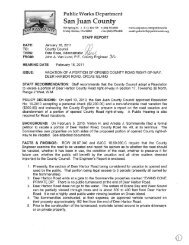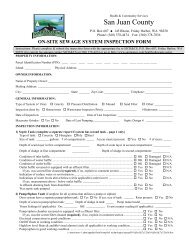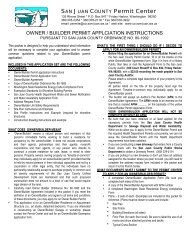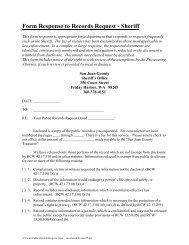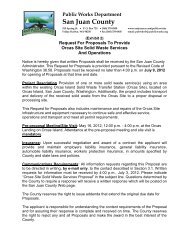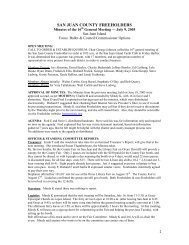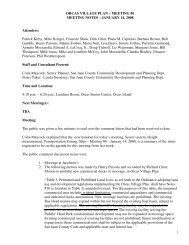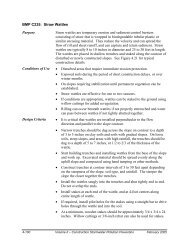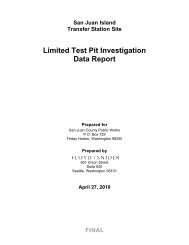Ordinance No._____- 2012 AN ORDINANCE ... - San Juan County
Ordinance No._____- 2012 AN ORDINANCE ... - San Juan County
Ordinance No._____- 2012 AN ORDINANCE ... - San Juan County
Create successful ePaper yourself
Turn your PDF publications into a flip-book with our unique Google optimized e-Paper software.
Habitat<br />
Bluff Backed<br />
Beaches<br />
Critical Salt<br />
Water<br />
Habitats<br />
Garry oak<br />
(Quercus<br />
garryana)<br />
woodlands<br />
and savannas<br />
Herbaceous<br />
Balds and<br />
Bluffs<br />
Pocket<br />
Beaches<br />
Includes erosional depositional beaches at the base sediment<br />
bluffs, sediment-covered rock beaches, and seeps/small streams<br />
that enter beaches via a bluff rather than via a pronounced stream<br />
valley. Bluff backed beaches do not form lagoons (though they<br />
may be a sediment source to barrier beaches that do form lagoons).<br />
Includes kelp beds; eelgrass beds; spawning and holding areas for<br />
forage fish including herring, smelt and sandlance; subsistence,<br />
commercial and recreational shellfish beds; mudflats; intertidal<br />
habitats with vascular plants; and areas with which priority species<br />
have a primary association.<br />
Garry oak is a type of Oregon White Oak found in warmer, drier<br />
areas within the Puget Sound and southern British Columbia. They<br />
are associated with what is becoming an increasingly rare<br />
ecosystem that supports a variety of rare wildflowers, butterflies<br />
(such as the Duskywing (Erynnis propertius)) and other plants and<br />
animals. Garry oak ecosystems are highly varied and are found in<br />
areas with rock outcrops, coastal bluffs, maritime meadows, and<br />
treeless grasslands as well as seasonal wetlands, and are sometimes<br />
found in mixed stands with other trees including arbutus and<br />
Douglas fir. Acorns from the oaks provide a key food for many<br />
birds, and other wildlife. Areas in the <strong>County</strong> that contain Garry<br />
oak include English Camp, Cady Mountain, <strong>San</strong> <strong>Juan</strong> Valley, the<br />
west side of <strong>San</strong> <strong>Juan</strong> Island, Point Disney, Turtleback Mountain,<br />
West Sound.<br />
Herbaceous Balds and Bluffs. These are native plant areas located<br />
on shallow soils over bedrock, often on steep, exposed slopes with<br />
few trees. They support grasses, herbaceous plants, dwarf shrubs,<br />
Brittle prickly pear cactus, mosses and lichens that are adapted for<br />
survival on shallow soils amid seasonally dry conditions. Trees<br />
that may be present include Douglas fir, Pacific madrone, and<br />
Garry oak. In <strong>San</strong> <strong>Juan</strong> <strong>County</strong> this habitat supports many plant<br />
species that are rare or that grow in few other land cover types.<br />
They are the preferred habitat of the Taylor’s Checkerspot<br />
butterfly, which is a listed species. Information on the plants<br />
associated with herbaceous balds and bluffs can be found at<br />
http://www1.dnr.wa.gov/nhp/refdesk/communities/pdf/balds_veg.<br />
pdf.<br />
Beaches that are contained between two bedrock headlands that<br />
essentially functions as a closed system in terms of littoral<br />
sediment transport. Pocket beaches do not typically occur within a<br />
drift cell and there is little or no exchange of sediment between a<br />
pocket beach and adjacent shores. They can be found waterward of<br />
a rocky bank or cliff, or they may form barriers, sometimes<br />
partially or completely isolating a back‐barrier lagoon or wetland.<br />
Pocket beaches are typically swash aligned, or oriented<br />
perpendicular to the direction of predominant wave approach.<br />
They are relatively short in length, as compared to the length of a<br />
Page 53 of 56<br />
Ord. ____-<strong>2012</strong><br />
Minimize and where possible<br />
remove hard shoreline<br />
armoring.<br />
Compliance with the <strong>San</strong> <strong>Juan</strong><br />
<strong>County</strong> C this code.<br />
Compliance with this codethe<br />
<strong>San</strong> <strong>Juan</strong> <strong>County</strong> Code.<br />
In conjunction with new<br />
development and vegetation<br />
removal, minimize<br />
disturbance of areas with<br />
Garry oak and associated<br />
native grasslands and<br />
wildflowers. Removal of<br />
Douglas fir and other conifers<br />
is encouraged to allow<br />
adequate sunlight for the oak,<br />
grasses and wildflowers. If<br />
disturbance cannot be avoided<br />
mitigate by replanting suitable<br />
areas with Garry oak, native<br />
grasses and wildflowers.<br />
In conjunction with new<br />
development and vegetation<br />
removal, minimize<br />
disturbance of herbaceous<br />
balds and bluffs.<br />
Minimize and where possible<br />
remove hard shoreline<br />
armoring.<br />
Compliance with thishe <strong>San</strong><br />
<strong>Juan</strong> <strong>County</strong> code code.<br />
N:\L<strong>AN</strong>D USE\LONG R<strong>AN</strong>GE PROJECTS\PCODES-11-0004 CAO FWHCAs\Docs from PC and CC\FWHCAOrdCC_<strong>2012</strong>-10-26.doc



